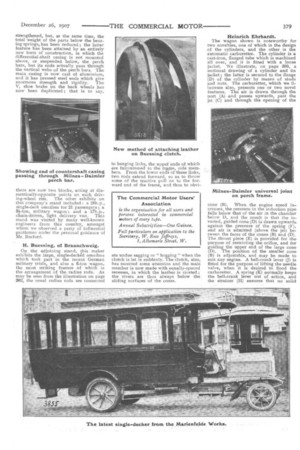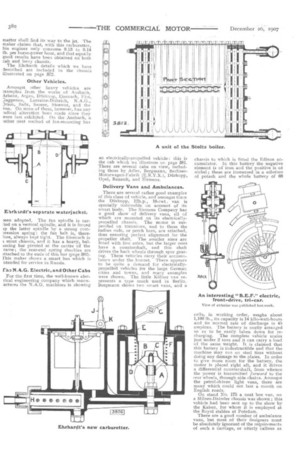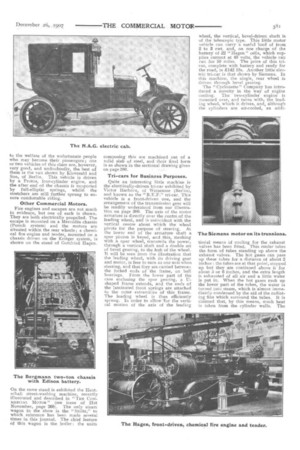At the Berlin Show.
Page 12

Page 13

Page 14

Page 15

Page 16

If you've noticed an error in this article please click here to report it so we can fix it.
The exhibition of commercial motors, which was opened in Berlin on Thursday last, the 19th instant, and was closed on the 22nd instant, was remarkable chiefly for the large number of vehicles suitable for the class of smaller tradesmen. Amongst the many machines of the tricar type, two or three makers appear to have succeeded in producing machines that are by no means freaks. The number of really useful and serviceable chassis of the heavier classes, say for from 24 up to 5 tons of useful load, are, however, very few ; they might be numbered possibly on the fingers of one hand. Most of the exhibits are decidedly weak in such vital parts as axles, bearing springs, steering gear and brakes. We are, at last, given an opportunity of witnessing the application of the much talked-of "Edison battery" to a commercial vehicle ; the chassis has the appearance of simple and sound construction and the battery certainly looks as though it ought to be successful, but, in the absence of any reliable or extensive test, on a commercial motor, we must refrain from giving any opinion on the subject ; we believe, however, that its inventor still drives a steam car.
Insufficient Space.
The two halls in which the show was held were by no means large enough to allow the vehicles so to be staged as to
show their best points ; some of the stands were so crowded, and their positions were so badly lighted, that during certain parts of the day it was almost impossible to make a satisfactory examination of the vehicles. Had all the plea.. sure vehicles been removed, the exhibition would, most certainly, have been more satisfactory. however, taking the show all round, it was a distinct advance on any previous attempt in Berlin, and it was very pleasing to note an utter absence of that officialism which characterises the Paris salon.
Daimler Motoren Gesellschaft.
From a practical user's point of view, the most interesking exhibit was the new 5-ton model of the Marienfelde works. This vehicle embodies the results of many years' experience with the hundreds of heavy machines which this company has built. Many of the points of the new vehicle have been the result of the advice and representations of Mr. H. G. Burford, M.I.Mech.E., the managing director of Milnes-Daimler, Ltd., of Tottenham Court Road. The 35h.p. engine is mounted at three points in a most practical manner, as also is the gear-box ; the latter has undergone considerable change in design, in order to obviate any possibility of the striking gear being affected by any warping of the frame. The whole of the striking gear, from the changespeed lever to the shifting rods and forks, is entirely self.contained with the upper part of the gear-box casting, and the only attachments to the main frame are the three points from which it is suspended. The clutch has also been altered to the extent of inverting the cone, and enclosing it completely so that the frictional surfaces are constantly lubricated ; leather has been abolished and the alu
minium, male cone is allowed to come into direct contact with the conical surface of the cast-steel flywheel. It is, however, behind the gear-box that the most radical departure from this maker's previous practice has been made. The perch bars arc brought inwards to the centre at their forward ends, as in last year's model, but, instead of pivoting them to brackets on a cross member, they are connected together, arid to the main frame, by a large universal joint, as shown in our detail photograph. This form of construction eliminates entirely all possibility of twisting of the perch bars owing to uneven road surfaces. The differential and bevel shafts have been
strengthened, but, at the same time, the total weight of the parts below the bearing springs, has been reduced ; the latter feature has been attained by an entirely new form of construction, in which the differential-shaft casing is not mounted above, or suspended below, the perch bars, but its ends actually pass through the vertical webs of the perch bars. The main casing is now cast of aluminium, and it has pressed steel ends which give enormous strength and rigidity. The V, shoe brake on the back wheels has now been duplicated ; that is to say,
there are now two blocks, acting at diametrically-opposite points on each driving-wheel rim. The other exhibits on this company's stand included : a 28h.p., single-deck omnibus for 21 passengers ; a Si-ton, military wagon ; and a 1711.p., chain-driven, light delivery van. This stand was visited by many well-known engineers from this country, amongst whom we observed a party of influential gentlemen under the personal guidance of Mr. Burford.
H. Buessing, of Braunchweig.
On the adjoining stand, this maker exhibits the large, single-decked omnibus which took part in the recent German military trials, and also a 6-ton wagon, the most striking feature of which is the arrangement of the radius rods. As may be seen from the illustration on page 382, the usual radius rods are connected
to hanging links, the upper ends of which are fulcrummed to the frame, side members. From the lower ends of these links, two rods extend forward, so as to throw some of the tractive pull art to the forward end of the frame, and thus to obvi ate undue sagging or " hogging " when the clutch is let in suddenly. The clutch, also, has received some attention and the male member is now made with equally-spaced recesses, in which the leather is riveted ; the 'rivets are thus always below the sliding surfaces of the cones.
Heinrich Ehrhardt.
The wagon shown is noteworthy for two novelties, one of which is the design of the cylinders, and the other is the automatic carburetter. The cylinder is a cast-iron, flanged tube which is machined all over, and it is fitted with a loose jacket. We illustrate, on page 380, a sectional drawing of a cylinder and its jacket ; the latter is secured to the flange (D) of the cylinder by means of studs and nuts. The carburetter, which we illustrate also, presents one or two novel features. The air is drawn through the port (A) and passes upwards, past the jet (C) and through the opening of the cone (B). When the engine speed increases, the pressure in the induction pipe. falls below that of the air in the chamber below D, and the result is that the inverted, guided cone (D) is drawn upwards. against the pressure of the spring (F), and air is admitted (above the jet) between the faces of the cones (B) and (D). The .throat piece (E) is provided for the purpose of restricting the orifice, and for guiding the upper end of the large cone (D). The position of the smaller cone (B) is adjustable, and may be made to suit any engine. A bell-crank lever (J) is fitted for the purpose of lifting the needle valve, when it is desired to flood the carburetter. A spring (K) .normally keeps the bell-crank lever out of action, and the strainer (H) ensures that no solid
matter shall find its way to the jet, The maker claims that, with this carburetter, his engines only consume 0.13 to 0.14 lb. per horse-power hour, and that equally good results have been obtained on both cab and lorry chassis.
The Ehrhardt details which we have described are included in the chassis illustrated on page 372.
Other Vehicles.
Amongst other heavy vehicles are ixamples from the works of Ansbach, Arbenz, Argue, DIU:lump, Eisenach, Fiat, 3aggenan, Lorraine-Dietrich, N.A.G., 3rion, Safir, Saurer, Stoewer, and the sun. On none of these, however, has any .adical alteration been made since they were last exhibited. On the Ansbach, .ather neat method of fan-mounting has
)een adopted. The fan spindle is car:ied on a vertical spindle, and it is forced ip the latter spindle by a strong corn)ression spring : the fan belt is, there:ore, always kept tight. The Eisenach is t stout chassis, and it has a heavy, bal. incing bar pivoted at the centre of the rame; the rear-end spring shackles are ittached to the ends of this bar (page 382). [his maker shows a smart bus which is ntended for service in Russia.
rite N. A.G. Electric, and Other Cabs
For the first time, the well-known elecrical engineering company which mann. actures the N.A.G, machines is showing an electrically-propelled vehicle : this is the cab which we illustrate on page 381. There are several cabs on view, including those by Adler, Bergmann, Berliner Motorwagen-Fabrik Diirkopp, Opel, Renault, and iernens.
Delivery Vans and Ambulances,
There are several rather good examples of this class of vehicle, and amongst these the Diirkopp, 12h.p., l0-cwt. van is specially noticeable on account of its smart body, The Siemens Company has a good show of delivery vans, all of which are mounted on its electricallypropelled chassis. The motor is suspended on trunnions, and to these the radius rods, or perch bars, are attached, thus ensuring perfect alignment for the propeller shaft. The smaller sizes are fitted with live axles, but the larger ones have a countershaft, and this shaft drives the hack wheels through spur gearing. These vehicles carry their accumulators under the bonnet. There appears to be quite a demand for electrically. propelled vehicles for the large German cities and towns, and many examples were shown. The little 1(61ner van represents a type much used in Berlin. Bergmann shows two smart vans, and a chassis to which is fitted the Edison accumulator. In this battery the negative element is of iron and the positive is of nickel ; these are immersed in a solution of potash and the whole battery of 68
cells, in working order, weighs about 1,100 lb., its capacity is 14 kilo-watt-hours and its normal rate of discharge is 45 amperes. The battery is neatly arranged so as to be easily taken down for recharging. The complete vehicle scales just under 2 tons and it can carry a load of the same weight. It is claimed that this battery is indestructible and that the machine may run on steel tires without doing any damage to the plates. In order to give more room for the battery, the motor is placed right aft, and it drives a differential countershaft, from whence the power is transmitted forward to the rear wheels, through side chains. Amongst the petrol-driven light vans, there are many which could not last a month on English roads.
On stand No. 175 a neat box van, on a Milnes-Daimler chassis was shown ; this vehicle had been sent up to the show by the Kaiser, for whom it is employed at the Royal stables at Potsdam.
There are a good number of ambulance vans, but most of their designers must be absolutely ignorant of the requirements of such a carriage, or utterly callous as
to the welfare of the unfortunate people who may become their passengers ; one or two vehicles of this class are, however, very good, and undoubtedly, the best of them is the van shown by Klevesahl and Son, of Berlin. This vehicle is driven by a Protos, four-cylinder engine, and the after end of the chassis is supported by full-elliptic springs, whilst the stretchers are still further sprung to ensure comfortable riding.
Other Commercial Motors.
Fire engines and escapes are not much in evidence, but one of each is shown. They are both electrically propelled. The escape is mounted on a Mercedes chassis (Porsch system) and the motors are situated within the rear wheels ; a cherni-cal fire engine and tender, mounted on a chassis driven on the Krieger system, is shown on the stand of Gottfried Hagen.
On the same stand is exhibited the Hentschall street-washing machine, recently illustrated and described in "THE Cont. BIRACIAL MOTOR" (see issue of 21st November, page 268). The only steam wagon in the show is the "Stoltz," to which reference has been made several times in this journal. The chief feature of this Wagon is the boiler the units
composing this are machined out of a solid slab of steel, and their final form is as shown in the sectional drawing given on page nal Tr-cars Tor Business Purposes.
Quite an interesting little machine is the electrically-driven tri-car exhibited by Victor Harborn, of Weisensee (Berlin), and known as the "B.E.F." tri-car. This vehicle is a front-driven one, and the arrangement of the transmission gear will be readily understood from our illustration on page 380. The axis of the motor armature is directly over the centre of the leading wheel, and is coincident with the vertical centre about which the wheel pivots for the purpose of steering. At the lower end of the armature shaft a spur pinion is keyed, and this, meshing with a spur wheel, transmits the power, through a vertical shaft and a double set of bevel gearing, to the hub of the wheel. It will be seen from the illustration that the leading wheel, with its driving gear and motor, is free to turn as one unit when steering, and that they are carried between the forked ends of the frame, on ball bearings. From the lower part of the case enclosing the spur gearing, a shaped frame extends, and the ends of the laminated front springs are attached to the outer extremities of this frame. The leading wheel is thus efficiently sprung. In order to allow for the vertical motion of the axis of the leading
wheel, the vertical, bevel-driven shaft is of the telescopic type. This little motor vehicle can carry a useful load of from 2 to 3 cwt. and, on one charge of the battery of 22 " Hagen " cells, which sup. plies current at 40 volts., the vehicle can run for 50 miles. The price of this tricar, complete with battery and ready for the road, is £142 10s. Another little electric tri-car is that shown by Siemens. In this machine, the single, rear wheel is driven through bevel gearing.
The " Cyclonette" Company has introduced a novelty in the way of engine cooling. The two-cylinder engine is mounted over, and turns with, the leading wheel, which it drives, and, although the cylinders are air-cooled, an addi tiortal means of cooling for the exhaust valves has been fitted. This cooler takes the form of tubes standing up above the exhaust valves. The hot gases can pass up these tubes for a distance of about 2 inches ; the tubes are at that point, stopped up but they are continued above it for about 5 or 6 inches, and the extra length is exhausted of all air and a little water is put in. When the hot gases rush up the lower part of the tubes, the water is turned into steam, which is almost immediately condensed by the aid of the radiating fins which surround the tubes. It is claimed that, by this means, much heat is taken from the cylinder walls, The tri-car is very much used by business houses in Berlin and for postal work.
Accessories and Components.
The galleries are entirely occupied by exhibits of tires, ball bearings, stampings, and other accessories and compo nents. Amongst the tire makers, the Continental Tyre Company's stand is by far the most imposing. Peter Union, Dunlop, and Metzen also have very fine shows. Quite a good show is the display of Sampson treads, and near this we noticed that the Stepney spare wheel was well in evidence. Quite a large business is being done in Berlin with this useful "spare." Hoffmann, and D.W.M. ball bearings were also shown. August Euler, of Frankfurt, had a very extensive display comprising: magnetos, castings, stampings, Hans RenoId chains, Norma ball bearings, and a host of other useful components.
A very convincing model of the Martini and Hiineke system of petrol storage, to which system reference was made in this journal on the 8th August last (see page 548), is illustrated below.
Notwithstanding the unfavourable conditions under which many of the exhibits were displayed, as regards access of light, we were impressed with the close amount of attention which many of the visitors, at no small pains to themselves, bestowed upon the various chassis, engines, etc.
German manufacturers appear to recognise that the field of the commercial motor is a somewhat restricted one in their own country, and to be sparing no pains to develop an export trade. So far as we were able to ascertain, the demand for the three-ton chassis, such as is suitable for typical omnibus work, has practically ceased, such enquiry as exists being for one-ton and five-ton vehicles.
We learnt, too, in the course of conversation with friends of our well-informed Berlin correspondent, that the present state of the industry is such as to have induced the military authorities to take into immediate consideration the placing of a large order for petrol-propelled chassis of the heavier patterns. The foregoing report deals with the novelties and points of interest which came under our notice, in the course of a careful inspection of the show, and it faithfully conveys to our readers such points as we consider require mention.






















